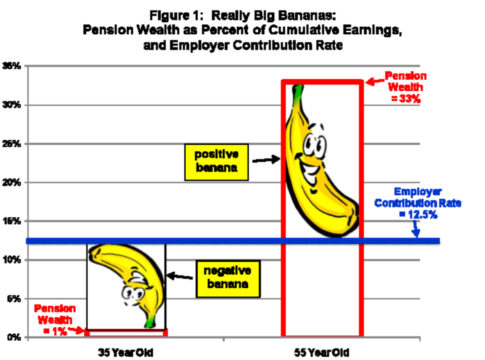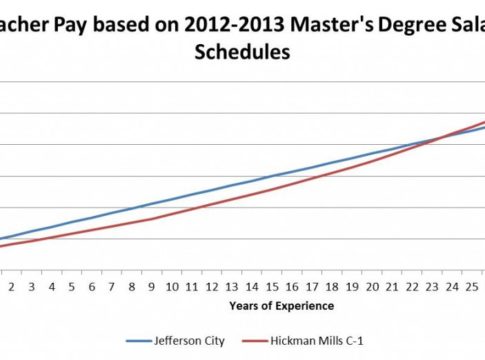Robert M. Costrell is professor of education reform and economics at the University of Arkansas. Michael Podgursky is professor of economics at the University of Missouri–Columbia.
For more than a decade, debate over reform of public pensions — including teachers — has been in a rut. On one side, some reformers have favored scrapping traditional teacher pension plans (defined benefit, or DB, of the “final average salary” type) in favor of the IRA-type plans received by most private-sector professionals (defined contribution, DC). On the other side, teacher unions, retiree groups, and DB pension plan professionals fight hard to protect existing plans.
Each side has legitimate points.
The critics of DB are correct that current plans are seriously underfunded in part because benefits are not tied to contributions. This makes plans vulnerable to gaming and juicing up of benefits formulae when stock market returns are good, which, of course, leaves the taxpayers and employers holding the bag when stock market returns turn south.
DB advocates are correct in that a movement from DB to DC can shift investment risks from employers to teachers. Last year’s stock market meltdown, which left many private sector professionals near retirement with inadequate savings, illustrates the problems associated with shifting these risks to employees. Moreover, DB advocates argue, many educators lack the expertise or interest to make efficient retirement portfolio planning decisions, and will make poor choices, while running up large fees in the process.
In two articles in Education Next, we have highlighted a different set of problems with most teacher pension plans. (The most recent article, “Golden Handcuffs,” was published today on the Ed Next website.) As currently configured, these plans create peculiar backloaded incentives that punish mobile teachers and push career teachers into retirement at relatively young ages. One of the key features that create these peculiarities is retirement eligibility rules that disproportionately reward the attainment of certain service benchmarks, such as “25-and-out” rules that encourage teachers to remain in the classroom for 25 years and then retire immediately thereafter. Another feature is the loss of employer contributions for teachers who leave before vesting. Removing the perverse incentives embedded in teacher pension plans could help to boost teacher quality by making the field more attractive to teachers with more varied career paths.
What those who are butting heads over DB vs. DC pensions may not realize is that there are other pension reform options besides the traditional DB and DC plans that can go some way toward addressing the concerns of both groups, and also alleviate the problems we identify with regard to mobility and retirement rules. For example, in our new article “Golden Handcuffs,” we illustrate how pension wealth would smoothly accrue under a “cash balance” (CB) plan of the type that has commonly been adopted in the private sector, and also a few places in the public sector. As with most current plans, educators and employers would make regular contributions. The pension fund would guarantee a fixed return on these contributions (which makes it a DB plan, both logically and legally). Each educator would get a notional account in the fund. This would grow each year based on the fixed return and new contributions (which makes it look similar to DC plans, except without the investment risk). When the educator chooses to retire, these returns could be converted into an annuity, just as in current DB plans, to make sure no one risks outliving their retirement savings.
There are two key points to note. First, and most important, investment risk and money management costs stay with the employer, which should please the advocates of DB plans. The pension fund would invest these funds and guarantee the return to the educator. Second, there would no longer be “peaks” and “valleys” in pension wealth accrual – one year would be the same as any other as far as pension wealth accrual is concerned. Unlike a DB plan, however, when teachers quit, the employer contributions would remain in the plan, and would continue to earn the fixed return until the educator chooses to retire.
Such a plan would help address many of the concerns of DB critics as well. Since the final annuity is directly tied to the history of employee and employer contributions and not the just the last few years of earnings, as in current plans, it is harder to game. Indeed, it is quite transparent for all to see how much has been contributed on the educator’s behalf. In addition, the mobility costs described in “Golden Handcuffs” would disappear or be greatly reduced. Teaching professionals who move from one state to another in the course of a teaching career would not suffer devastating losses in pension wealth as they do in the current system.
There would, of course, be issues to debate. The degree of generosity can vary, depending both on the employer contribution rate and the guaranteed rate of return. And the fund managers may still make overly risky investments that can leave the plan underfunded, although one suspects there will be less temptation to do so if the guaranteed return approximates the rate on risk-free investments, as is typically the case.
But the key point to understand is that there is nothing inherent in DB plans that require they have the peculiar incentives and penalties that we currently observe. It is possible to design DB plans that keep the investment risk with the employer, but allow smoother and fairer accrual of pension wealth for educators.
The costs of current teacher pension plans are rising rapidly and their sustainability is in question. This is forcing policymakers to consider changes and reforms. In thinking about reform, it is important for policymakers to understand that the DB versus DC – either/or — dichotomy is not helpful. As we have seen, CB plans have features of both. In addition, there is a continuum of options available that includes hybrids of various sorts, with components of CB, DC, and traditional final average salary plans . Indeed, why require that one size fits all? Some teachers may want the freedom to invest at least some of their own funds, and hybrid plans such as TIAA-CREF, which include DC options, as well as CB-type of guaranteed-return funds with annuitization, offer such flexibility.
Actuaries are quite well aware of our main point here: that DB plans, which keep investment risk with the employer, need not generate peculiar incentives and uneven distribution of pension wealth. Concerning the accrual of pension wealth, one actuary noted – “you can make the lines look however you want.” And “how the lines look” should be a central focus of reform discussions. What type of deferred compensation plan (and associated pension wealth accrual) is the best way to recruit, retain, and motivate a high quality teaching workforce?
NB: You can listen to a new Ed Next podcast in which we discuss teacher pension reform here and you can watch an interview about the ways that teacher pension plans punish short-term and mobile teachers and reward teachers who spend their entire career teaching in one state here.





